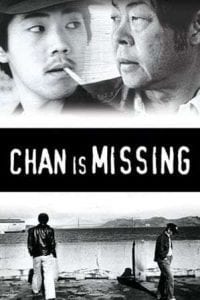Chan Is Missing
Chan is Missing (1982) is an experimental comedy-drama film released in 1982. It is produced and  directed by 33-year-old Wayne Wang from San Francisco on a $22,000 budget. The movie stars Wood Moy and Marc Hayashi and incorporates music by Robert Kikuchi-Yngojo. The film is thought to be the FIRST Asian-American film to gain critical acclaim outside of the Asian American community and was highly praised by many critics (Rated 100% on Rotten Tomatoes and 7/10 on IMDb). According to Dennis Schwartz, Chan is Missing is “breezy and warmly done, a low-key comedy that takes you into an ethnic group that has rarely been captured on film in such a revealing way”.
directed by 33-year-old Wayne Wang from San Francisco on a $22,000 budget. The movie stars Wood Moy and Marc Hayashi and incorporates music by Robert Kikuchi-Yngojo. The film is thought to be the FIRST Asian-American film to gain critical acclaim outside of the Asian American community and was highly praised by many critics (Rated 100% on Rotten Tomatoes and 7/10 on IMDb). According to Dennis Schwartz, Chan is Missing is “breezy and warmly done, a low-key comedy that takes you into an ethnic group that has rarely been captured on film in such a revealing way”.
The story of the film revolves around two men who, in order to purchase a taxicab license, has approached a third man, Chan Hung. However, at the beginning of the film, Chan disappears with their money. The search for Chan is conducted by talking to various people in Chinatown, all of who have contradictory images and memories of the man. While the money does get returned in the end, Chan remains missing and the two men conclude that Chan is an enigma.
One of the unique features of this film is the bilingual aspect, as originally the film did not have subtitles for the Chinese dialogue. The reason for Wang’s decision to not include subtitles is based on his belief that the audience would be able to understand the feeling of the scene from tone, gestures, etc. without actually knowing the content of the dialogue. This allowed the non-Chinese speaking audience to focus more on the visual images rather than the words used in the film
Another one of the themes is the Asian American characters’ diversity, something that had never been explored previously in American movies. This diversity is represented through Chan’s character, who we never meet and never truly understand. Each individual in Chinatown has a separate impression of him – “slow”, “sly”, “honest and trustworthy”, “a failure”, “a hard-headed political activist, etc. Rather than being a distinct character with unclear traits, he instead is a representation of Chinatown as a whole; he shows the audience that the Chinatown community is capable of having all of the above traits and more.
Sources:
“Chan Is Missing.” The Match Factory, www.the-match-factory.com/catalogue/films/chan-is-missing.html.
Canby, Vincent. “‘CHAN IS MISSING’ IN CHINATOWN.” The New York Times, The New York Times, 24 Apr. 1982, www.nytimes.com/1982/04/24/movies/chan-is-missing-in-chinatown.html.